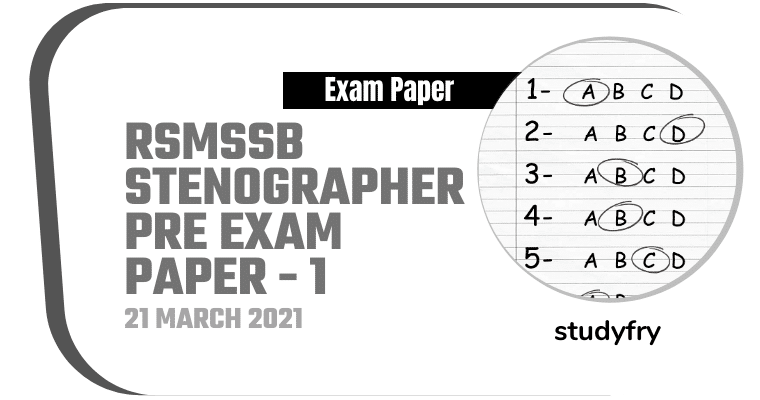81. Biomass does not include
(A) cowdung
(B) wood
(C) agriculture waste
(D) metals
बायोमास में शामिल नहीं है
(A) गोबर
(B) लकड़ी
(C) कृषि अपशिष्ट
(D) धातुएँ
Show Answer
Hide Answer
82. The term biomass most often refers to
(A) Ammonium compounds
(B) Inorganic matter
(C) Organic matter
(D) Chemicals
बायोमास शब्द ज्यादातर संदर्भित करता है
(A) अमोनियम यौगिकों को
(B) अकार्बनिक पदार्थ को
(C) कार्बनिक पदार्थ को
(D) रसायनों को
Show Answer
Hide Answer
83. Ecosystem is the smallest unit of
(A) Mesosphere
(B) lonosphere
(C) Lithosphere
(D) Biosphere
पारिस्थितिकी-तंत्र ____ की सबसे छोटी इकाई है।
(A) मध्यमंडल
(B) आयनमंडल
(C) स्थलमंडल
(D) जीवमंडल
Show Answer
Hide Answer
84. The DNA threads which appear inside the nucleus at the time of cell division is
(A) Chromosomes
(B) Spindle fibres
(C) Centrioles
(D) Asters
कोशिका विभाजन के समय केन्द्रक के अंदर दृश्यमान DNA थ्रेड है
(A) गुणसूत्र
(B) स्पिंडल फाइबर
(C) तारककेन्द्र
(D) तारक
Show Answer
Hide Answer
85. Humans have ___pairs of autosomes.
मनुष्य में ऑटोसोम के ____जोड़े होते हैं।
(A) 23
(B) 18
(C) 22
(D) 21
Show Answer
Hide Answer
86. The set of ecosystems is called a
(A) Structure
(B) Biome
(C) Climate
(D) Subsystem
पारिस्थितिकी-तंत्र के समुच्चय को कहा जाता है एक
(A) संरचना
(B) जीवोम
(C) जलवायु
(D) उप-प्रणाली
Show Answer
Hide Answer
87. Properties of element are determined by
(A) Protons
(B) Atomic number
(C) Atomic weight
(D) Neutrons
तत्त्व के गुण किसके द्वारा निर्धारित किये जाते हैं ?
(A) प्रोटॉन
(B) परमाणु क्रमांक
(C) परमाणु भार
(D) न्यूट्रॉन
Show Answer
Hide Answer
88. The element present in the largest amount in atmosphere is
(A) Aluminium
(B) Nitrogen
(C) Silicon
(D) Hydrogen
वातावरण में सबसे अधिक मात्रा में मौजूद तत्त्व है
(A) एलुमिनियम
(B) नाइट्रोजन
(C) सिलिकॉन
(D) हाइड्रोजन
Show Answer
Hide Answer
89. The most abundant element in the universe is
(A) Silicon
(B) Oxygen
(C) Hydrogen
(D) Carbon dioxide
ब्रह्मांड में सबसे प्रचुर तत्त्व है :
(A) सिलिकॉन
(B) ऑक्सीजन
(C) हाइड्रोजन
(D) कार्बन डाइऑक्साइड
Show Answer
Hide Answer
90. Which of the following is a pure substance made up of one type of atoms?
(A) None of these
(B) Compound
(C) Element
(D) Mixture
निम्नलिखित में से कौन सा एक प्रकार के परमाणुओं से बना शुद्ध पदार्थ है ?
(A) इनमें से कोई नहीं
(B) यौगिक
(C) तत्त्व
(D) मित्रण
Show Answer
Hide Answer
91. Which of the following is the smallest part of a compound, whose properties are the same as those of the compound ?
(A) Atom
(B) Molecule
(C) Element
(D) Mixture
निम्नलिखित में से कौन सा एक यौगिक का सबसे छोटा भाग है जिसके गुण यौगिक के समान होते हैं ?
(B) अणु
(C) तत्त्व
(D) मिश्रण
Show Answer
Hide Answer
92. Which of the following is a pure substance made up of two or more types of atoms or elements ?
(A) All of these
(B) Mixture
(C) Compound
(D) Element
निम्नलिखित में से कौन सा एक शुद्ध पदार्थ है जो दो या अधिक प्रकार के परमाणुओं या तत्त्वों से बना होता है ?
(A) यह सभी
(B) मिश्रण
(C) यौगिक
(D) तत्त्व
Show Answer
Hide Answer
93. Which one of the following is a mixture ?
(A) Water
(B) Iron sulphide
(C) Sea water
(D) Oxygen
निम्न में से कौन सा एक मिश्रण है ?
(A) पानी
(B) आयरन सल्फाइड
(C) समुद्र का पानी
(D) ऑक्सीजन
Show Answer
Hide Answer
94. Which one of the following may be classified as a compound and as a molecule ?
(A) Sodium
(B) Oxygen
(C) Water
(D) Crude oil
निम्नलिखित में से कौन सा एक यौगिक के रूप में और एक अणु के रूप में भी वर्गीकृत किया जा सकता है ?
(A) सोडियम
(B) ऑक्सीजन
(C) पानी
(D) कच्चा तेल
Show Answer
Hide Answer
95. H2O and FeS represent
(A) None
(B) compounds
(C) mixtures
(D) clements
H2O और Fes किसका प्रतिनिधित्व करते हैं ?
(A) इनमें से कोई नहीं
(B) यौगिक
(C) मिश्रण
(D) तत्व
Show Answer
Hide Answer
96. Souring of milk at room temperature involves
(A) None of these
(B) Physical change
(C) Chemical change
(D) Physical and chemical change both
कक्ष तापमान पर दूध के खट्टा होने में शामिल है
(A) इनमें से कोई नहीं
(B) भीतिक परिवर्तन
(C) रासायनिक परिवर्तन
(D) भीतिक और रासायनिक परिवर्तन दोनों
Show Answer
Hide Answer
97. In which type of change a new substance is formed ?
(A) None of these
(B) In physical change
(C) In chemical change
(D) In both physical and chemical change
किस प्रकार के परिवर्तन में एक नया पदार्थ बनता है ?
(A) इनमें से कोई नहीं
(B) भौतिक परिवर्तन में
(C) रासायनिक परिवर्तन में
(D) भौतिक और रासायनिक परिवर्तन दोनों में
Show Answer
Hide Answer
98. Which one of the following elements is a non-metal ?
(A) Carbon
(B) Iron
(C) Gold
(D) Zinc
निम्न में से कौन सा तत्त्व अधातु है ?
(A) कार्बन
(B) लोहा
(C) सोना
(D) जिंक
Show Answer
Hide Answer
99. Which among the following is a physical change ?
(A) Cooking of food
(B) Cutting a log of wood in small pieces
(C) Burning of wood
(D) Ripcning of fruit
निम्न में से कौन सा एक भौतिक परिवर्तन है ?
(A) भोजन पकाना
(B) लकड़ी के लट्टे को छोटे टुकड़ों में काटना
(C) लकड़ी जलाना
(D) फलों का पकना
Show Answer
Hide Answer
100. Which of the following is not a chemical change?
(A) Melting of wax
(B) Rusting of iron
(C) Combustion of magnesium ribbon
(D) Burning of candle
निम्न में से कौन सा एक रासायनिक परिवर्तन नहीं है ?
(A) मोम का पिघलना
(B) लोहे में जंग लगना
(C) मैग्नीशियम रिबन का दहन
(D) मोमबत्ती का जलना
Show Answer
Hide Answer
